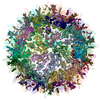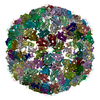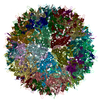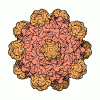+ Open data
Open data
- Basic information
Basic information
| Entry | Database: PDB / ID: 5urf | ||||||
|---|---|---|---|---|---|---|---|
| Title | The structure of human bocavirus 1 | ||||||
 Components Components | viral protein 3 | ||||||
 Keywords Keywords | VIRUS LIKE PARTICLE / HBoV1 / human parvovirus 1 / parvovirus / respiratory tract infection | ||||||
| Function / homology |  Function and homology information Function and homology informationphospholipase A2 activity / phospholipase A2 / T=1 icosahedral viral capsid / lipid catabolic process / viral capsid / host cell cytoplasm / host cell nucleus / structural molecule activity Similarity search - Function | ||||||
| Biological species |  Human bocavirus 1 Human bocavirus 1 | ||||||
| Method | ELECTRON MICROSCOPY / single particle reconstruction / cryo EM / Resolution: 2.9 Å | ||||||
 Authors Authors | Mietzsch, M. / Kailasan, S. / Garrison, J. / Ilyas, M. / Chipman, P. / Kandola, K. / Jansen, M. / Spear, J. / Sousa, D. / McKenna, R. ...Mietzsch, M. / Kailasan, S. / Garrison, J. / Ilyas, M. / Chipman, P. / Kandola, K. / Jansen, M. / Spear, J. / Sousa, D. / McKenna, R. / Soderlund-Venermo, M. / Baker, T. / Agbandje-McKenna, M. | ||||||
 Citation Citation |  Journal: J Virol / Year: 2017 Journal: J Virol / Year: 2017Title: Structural Insights into Human Bocaparvoviruses. Authors: Mario Mietzsch / Shweta Kailasan / Jamie Garrison / Maria Ilyas / Paul Chipman / Kalle Kantola / Mandy E Janssen / John Spear / Duncan Sousa / Robert McKenna / Kevin Brown / Maria Söderlund- ...Authors: Mario Mietzsch / Shweta Kailasan / Jamie Garrison / Maria Ilyas / Paul Chipman / Kalle Kantola / Mandy E Janssen / John Spear / Duncan Sousa / Robert McKenna / Kevin Brown / Maria Söderlund-Venermo / Timothy Baker / Mavis Agbandje-McKenna /    Abstract: Bocaparvoviruses are emerging pathogens of the family. Human bocavirus 1 (HBoV1) causes severe respiratory infections and HBoV2 to HBoV4 cause gastrointestinal infections in young children. Recent ...Bocaparvoviruses are emerging pathogens of the family. Human bocavirus 1 (HBoV1) causes severe respiratory infections and HBoV2 to HBoV4 cause gastrointestinal infections in young children. Recent reports of life-threatening cases, lack of direct treatment or vaccination, and a limited understanding of their disease mechanisms highlight the need to study these pathogens on a molecular and structural level for the development of therapeutics. Toward this end, the capsid structures of HBoV1, HBoV3, and HBoV4 were determined to a resolution of 2.8 to 3.0 Å by cryo-electron microscopy and three-dimensional image reconstruction. The bocaparvovirus capsids, which display different tissue tropisms, have features in common with other parvoviruses, such as depressions at the icosahedral 2-fold symmetry axis and surrounding the 5-fold symmetry axis, protrusions surrounding the 3-fold symmetry axis, and a channel at the 5-fold symmetry axis. However, unlike other parvoviruses, densities extending the 5-fold channel into the capsid interior are conserved among the bocaparvoviruses and are suggestive of a genus-specific function. Additionally, their major viral protein 3 contains loops with variable regions at their apexes conferring capsid surface topologies different from those of other parvoviruses. Structural comparisons at the strain (HBoV) and genus (bovine parvovirus and HBoV) levels identified differences in surface loops that are functionally important in host/tissue tropism, pathogenicity, and antigenicity in other parvoviruses and likely play similar roles in these viruses. This study thus provides a structural framework to characterize determinants of host/tissue tropism, pathogenicity, and antigenicity for the development of antiviral strategies to control human bocavirus infections. Human bocaviruses are one of only a few members of the family pathogenic to humans, especially young children and immunocompromised adults. There are currently no treatments or vaccines for these viruses or the related enteric bocaviruses. This study obtained the first high-resolution structures of three human bocaparvoviruses determined by cryo-reconstruction. HBoV1 infects the respiratory tract, and HBoV3 and HBoV4 infect the gastrointestinal tract, tissues that are likely targeted by the capsid. Comparison of these viruses provides information on conserved bocaparvovirus-specific features and variable regions resulting in unique surface topologies that can serve as guides to characterize HBoV determinants of tissue tropism and antigenicity in future experiments. Based on the comparison to other existing parvovirus capsid structures, this study suggests capsid regions that likely control successful infection, including determinants of receptor attachment, host cell trafficking, and antigenic reactivity. Overall, these observations could impact efforts to design antiviral strategies and vaccines for HBoVs. | ||||||
| History |
|
- Structure visualization
Structure visualization
| Movie |
 Movie viewer Movie viewer |
|---|---|
| Structure viewer | Molecule:  Molmil Molmil Jmol/JSmol Jmol/JSmol |
- Downloads & links
Downloads & links
- Download
Download
| PDBx/mmCIF format |  5urf.cif.gz 5urf.cif.gz | 5.1 MB | Display |  PDBx/mmCIF format PDBx/mmCIF format |
|---|---|---|---|---|
| PDB format |  pdb5urf.ent.gz pdb5urf.ent.gz | Display |  PDB format PDB format | |
| PDBx/mmJSON format |  5urf.json.gz 5urf.json.gz | Tree view |  PDBx/mmJSON format PDBx/mmJSON format | |
| Others |  Other downloads Other downloads |
-Validation report
| Summary document |  5urf_validation.pdf.gz 5urf_validation.pdf.gz | 1 MB | Display |  wwPDB validaton report wwPDB validaton report |
|---|---|---|---|---|
| Full document |  5urf_full_validation.pdf.gz 5urf_full_validation.pdf.gz | 1.1 MB | Display | |
| Data in XML |  5urf_validation.xml.gz 5urf_validation.xml.gz | 665.6 KB | Display | |
| Data in CIF |  5urf_validation.cif.gz 5urf_validation.cif.gz | 1 MB | Display | |
| Arichive directory |  https://data.pdbj.org/pub/pdb/validation_reports/ur/5urf https://data.pdbj.org/pub/pdb/validation_reports/ur/5urf ftp://data.pdbj.org/pub/pdb/validation_reports/ur/5urf ftp://data.pdbj.org/pub/pdb/validation_reports/ur/5urf | HTTPS FTP |
-Related structure data
| Related structure data |  8598MC  8604C  8605C  5us7C  5us9C M: map data used to model this data C: citing same article ( |
|---|---|
| Similar structure data |
- Links
Links
- Assembly
Assembly
| Deposited unit | 
|
|---|---|
| 1 |
|
- Components
Components
| #1: Protein | Mass: 60568.301 Da / Num. of mol.: 60 Source method: isolated from a genetically manipulated source Source: (gene. exp.)  Human bocavirus 1 / Production host: Human bocavirus 1 / Production host:  |
|---|
-Experimental details
-Experiment
| Experiment | Method: ELECTRON MICROSCOPY |
|---|---|
| EM experiment | Aggregation state: PARTICLE / 3D reconstruction method: single particle reconstruction |
- Sample preparation
Sample preparation
| Component | Name: human bocavirus 1 / Type: VIRUS / Entity ID: all / Source: RECOMBINANT |
|---|---|
| Source (natural) | Organism:  Human bocavirus 1 Human bocavirus 1 |
| Details of virus | Empty: YES / Enveloped: NO / Isolate: SEROTYPE / Type: VIRUS-LIKE PARTICLE |
| Natural host | Organism: Homo sapiens |
| Buffer solution | pH: 7.4 |
| Specimen | Embedding applied: NO / Shadowing applied: NO / Staining applied: NO / Vitrification applied: YES |
| Vitrification | Cryogen name: ETHANE |
- Electron microscopy imaging
Electron microscopy imaging
| Experimental equipment |  Model: Titan Krios / Image courtesy: FEI Company |
|---|---|
| Microscopy | Model: FEI TITAN KRIOS |
| Electron gun | Electron source:  FIELD EMISSION GUN / Accelerating voltage: 300 kV / Illumination mode: FLOOD BEAM FIELD EMISSION GUN / Accelerating voltage: 300 kV / Illumination mode: FLOOD BEAM |
| Electron lens | Mode: BRIGHT FIELD |
| Image recording | Electron dose: 63 e/Å2 / Film or detector model: DIRECT ELECTRON DE-20 (5k x 3k) |
- Processing
Processing
| Software | Name: PHENIX / Version: 1.10-2155_2155: / Classification: refinement | ||||||||||||||||||||||||
|---|---|---|---|---|---|---|---|---|---|---|---|---|---|---|---|---|---|---|---|---|---|---|---|---|---|
| CTF correction | Type: PHASE FLIPPING AND AMPLITUDE CORRECTION | ||||||||||||||||||||||||
| 3D reconstruction | Resolution: 2.9 Å / Resolution method: FSC 0.143 CUT-OFF / Num. of particles: 31064 / Symmetry type: POINT | ||||||||||||||||||||||||
| Refine LS restraints |
|
 Movie
Movie Controller
Controller













 PDBj
PDBj



